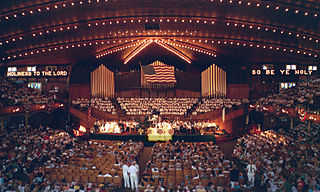Related Research Articles

Ocean Grove is an unincorporated community and census-designated place (CDP) that is part of Neptune Township, in Monmouth County, in the U.S. state of New Jersey. It had a population of 3,057 at the 2020 United States census. It is located on the Atlantic Ocean's Jersey Shore, between Asbury Park to the north and Bradley Beach to the south. Listed on the National Register of Historic Places, Ocean Grove is noted for its abundant examples of Victorian architecture and the Great Auditorium, acclaimed as "the state’s most wondrous wooden structure, soaring and sweeping, alive with the sound of music".

A dormitory is a building primarily providing sleeping and residential quarters for large numbers of people such as boarding school, high school, college or university students. In some countries, it can also refer to a room containing several beds accommodating people.

The Stellafane Observatory is an astronomical observatory in Springfield, Vermont, founded in 1920 by Russell W. Porter. The Pink Clubhouse was built in 1923 at the site by the Springfield Telescope Makers Club. The name Stellafane, suggested by Porter at the club's December 1923 meeting, is derived from the Latin words stella and fanum meaning "Shrine to the Stars", and originally referred specifically to the clubhouse, but has since come to refer to all of the club's land and buildings on the summit of Breezy Hill, west of downtown Springfield.

The Brisbane Showgrounds is a multi-purpose venue located in Bowen Hills, Brisbane. Established in 1875, it hosts more than 250 events each year, the largest being the Royal Queensland Show (Ekka).

Washington Crossing Council serves Bucks County, Pennsylvania, Mercer County, New Jersey and Hunterdon County, New Jersey. The council was founded as Bucks County Council on August 13, 1928, and changed its name to Washington Crossing Council after receiving portions of the dissolved Central New Jersey Council.

Mount Tabor is an unincorporated community and census-designated place (CDP) established as a self-governing Methodist camp meeting in what is now Parsippany–Troy Hills, in Morris County, in the U.S. state of New Jersey.

The Harvey Cedars Hotel is the last remaining historic hotel of its size located on Long Beach Island, in the town of Harvey Cedars, New Jersey, United States. It began as a one-story house constructed by Sylvanus Cox between "soon after the War of 1812" and 1837. In 1841, Captain Samuel Perrine purchased and expanded the house into the two-story "Connahassett House at Harvest Cedars," which served as a boarding house for fishermen and duck hunters. Its biggest attraction was its public dance hall on the south side of the building. Sailing parties from other hotels came for lively square dances and reels on summer evenings.

The Patriots' Path Council is a not-for-profit organization that establishes ideals in youth to help them make ethical choices by instilling values of good character, citizenship, personal fitness, and guidance. It serves members in the counties of Morris, Sussex, Somerset, Union, Hunterdon, and parts of Middlesex in New Jersey. It was established in 1999 with the merger of the Morris-Sussex Area Council (1936–1999) and the Watchung Area Council (1926–1999). On February 6, 2014, Patriots Path Council absorbed several Scouting units from the dissolved Central New Jersey Council (1999-2014).

Northeastern Pennsylvania Council, with headquarters in Moosic, Pennsylvania, formed in 1990 from the merger of Forest Lakes Council and Penn Mountains Council of the Boy Scouts of America. It covers the metropolitan area of Scranton and Wilkes-Barre, Pennsylvania. The council serves Lackawanna, Luzerne, Pike, Wayne, Wyoming counties, and portions of Susquehanna county.

Camp Tosebo, on the south shore of Portage Lake in Onekama Township, Michigan, was established in 1912 by Noble Hill, the headmaster of the Todd Seminary for Boys in Woodstock, Illinois, as one of the first summer camps in the United States. The name of the camp is an acronym derived from the school's name, TOdd SEminary for BOys, and meant to sound like a Native American Indian word. The camp was listed on the National Register of Historic Places in 2000.

Wesleyan Grove is a 34-acre (14 ha) National Historic Landmark District in Oak Bluffs, Massachusetts on the island of Martha's Vineyard. Named after John Wesley, the founder of the Methodist Church. Also known as the Martha's Vineyard Campmeeting Association (MVCMA) or the Campgrounds, it was the first summer religious camp established in the United States. It is famous for its approximately 300 colourful cottages in a style now described as Carpenter Gothic.

The Yarmouth Camp Ground Historic District is a historic district encompassing a religious summer camp meeting ground in Yarmouth and Barnstable, Massachusetts. The core of the camp ground was purchased in 1863 by the Sandwich District Camp Meeting Association, a Methodist Episcopal organization, and was operated until 1939. The area contains a well-preserved collection of predominantly residential buildings built during this period; it was listed on the National Register of Historic Places in 1990.
Arlington Beach is a hamlet in the Canadian province of Saskatchewan. It is located on the eastern shore of Last Mountain Lake, north-west of Regina. Listed as a designated place by Statistics Canada, the hamlet had a population of 39 in the Canada 2006 Census.

Indian Field Methodist Campground is a camp meeting site for the Methodist Church in Dorchester County, South Carolina. It is on SC Route S-18-73, off US Route 15, about 5 mi (8 km) north of Saint George. Indian Field was built in 1848 and has been a site for religious gatherings for over 160 years. It is associated with the Indian Field United Methodist Church located on U.S. Highway 15 about 2 miles (3 km) north of the campground and just south of U.S. Highway 178. It was named a historic district of the National Register of Historic Places on March 30, 1973.

Asbury Grove, located in Hamilton, Massachusetts, was formed during the camp meeting religious movement popular in the mid-19th century. Originally set on seventy-five acres of land, the camp was founded by the Methodist church in 1857. Ten of the original seventy-five acres were purchased from Joseph Dodge, a local farmer. This land included a farmhouse, which later became the Superintendent's Cottage.

John Holmes House, also known as the Cresse–Holmes House, is located at 504 U.S. Route 9 North in the Cape May Court House section of Middle Township in Cape May County, New Jersey. It was added to the National Register of Historic Places on June 12, 1979, for its significance in vernacular Georgian architecture. It was documented by the Historic American Buildings Survey in 1992.
The W. D. Boyce Council of the Boy Scouts of America serves youth in central Illinois, from Lincoln to Ottawa, and Peoria to Bloomington.

The Mountain Grove Campground was a campground, active between 1872 and 1901, that formed part of the 19th- to early 20th-century camp meeting movement, where camping was combined with worshiping and listening to preachers. These meetings were often held by Protestants, in this case, Methodists. Mountain Grove Campground was a site and resort on the Danville, Hazleton and Wilkes-Barre Railroad in Black Creek Township, Luzerne County, Pennsylvania, in the United States. It existed for approximately 30 years and was run by the Mountain Grove Camp Meeting Association. A businessman named G.M. Shoop was the original owner of the campground's land. Many prominent citizens of the surrounding area were in the association. During the campground's operation between 1872 and 1901, it was renovated and expanded several times. While the camp meetings that were held there were intended for Methodists, non-Methodists occasionally attended them.

Villa Garnier is a building in Bordighera in western Italy. Villa Garnier and Villa Amica are part of the properties protected by the Superintendent of Ministry of Cultural Heritage and Activities and Tourism (Italy). The villa is located 11 Garnier Street in Bordighera on the Italian Riviera.

The Royal Pavilion, also known as the Queen's Pavilion, was a royal residence located at Aldershot in Hampshire. The most unpretentious of all royal residences, it was built by George Myers as a wooden structure in 1855 for Queen Victoria and Prince Albert for use by members of the Royal Family when in Aldershot to attend military reviews and other occasions. Located off the Farnborough Road opposite the former West Cavalry Barracks, nearby are the Royal Garrison Church and the Wellington Statue. It was dismantled in the early 1960s. Today the site is the location of the Royal Pavilion Office Park.